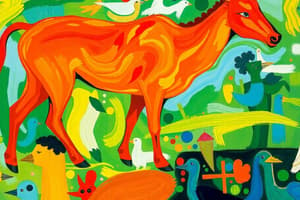Podcast
Questions and Answers
What does population density measure?
What does population density measure?
- Distribution of individuals among different ages
- Proportion of males to females in a population
- Total number of individuals in a population
- Number of individuals per unit area or volume (correct)
Which distribution pattern describes individuals that are evenly spaced due to territorial behavior?
Which distribution pattern describes individuals that are evenly spaced due to territorial behavior?
- Clumped Distribution
- Uniform Distribution (correct)
- Random Distribution
- Dense Distribution
How does age structure affect a population's growth potential?
How does age structure affect a population's growth potential?
- Older populations are always more stable
- Young populations are likely to decline faster
- Age structure has no impact on population dynamics
- Populations with many young individuals are likely to grow (correct)
The sex ratio in a population influences what aspect of the population?
The sex ratio in a population influences what aspect of the population?
Which of the following best describes clumped distribution?
Which of the following best describes clumped distribution?
What is a key focus of population ecology?
What is a key focus of population ecology?
Which of the following is NOT an aspect of population size?
Which of the following is NOT an aspect of population size?
If a population has a high ratio of elderly individuals, what is most likely to happen?
If a population has a high ratio of elderly individuals, what is most likely to happen?
What describes the situation in which a population grows exponentially?
What describes the situation in which a population grows exponentially?
Which factor is considered a density-dependent factor affecting population size?
Which factor is considered a density-dependent factor affecting population size?
What is the carrying capacity (K) in population ecology?
What is the carrying capacity (K) in population ecology?
Which of the following is NOT an example of a density-independent factor that affects population size?
Which of the following is NOT an example of a density-independent factor that affects population size?
What is a method used to mitigate the negative impacts of human activities on wildlife populations?
What is a method used to mitigate the negative impacts of human activities on wildlife populations?
Which of the following actions contributes to population declines in species?
Which of the following actions contributes to population declines in species?
Why is understanding population ecology important for conservation efforts?
Why is understanding population ecology important for conservation efforts?
Flashcards are hidden until you start studying
Study Notes
Introduction to Population Ecology
- Population ecology studies the dynamics of populations, focusing on size, density, distribution, and changes over time.
- A population is a group of interbreeding individuals of the same species in a specific area.
- Knowledge of population ecology aids in managing resources, conserving endangered species, and understanding human impacts on ecosystems.
Key Concepts in Population Ecology
Population Size and Density
- Population Size: Total number of individuals in a population (e.g., 500 deer in a forest).
- Population Density: Number of individuals per unit area (e.g., 5 deer per square kilometer in a 100-sq km forest).
Population Distribution
- Clumped Distribution: Individuals group in patches due to resource availability (e.g., plants in nutrient-rich soil).
- Uniform Distribution: Individuals evenly spaced due to territorial behavior (e.g., nesting penguins).
- Random Distribution: Individuals spread unpredictably, rarely occurring in nature.
Age Structure
- Age Structure: Distribution of individuals across various ages, indicating growth potential.
- A younger population tends to grow, while an older demographic may decline.
Sex Ratio
- Sex Ratio: Proportion of males to females, influencing reproductive rates.
- A higher number of females can lead to faster population growth.
Population Growth Models
- Population growth indicates changes in the number of individuals over time, described by two main models:
Exponential Growth
- Occurs in ideal conditions with unlimited resources, with population size increasing at a constant rate.
- Mathematical formula: N(t)=N0ert, where:
- N(t) = population size at time t
- N0 = initial population size
- r = intrinsic rate of increase (birth rate - death rate)
- Rare in nature but may occur in newly introduced species with abundant resources.
Logistic Growth
- Most populations undergo logistic growth, with an initial rapid increase that slows as resources become limited.
- Formula: N(t)=K+N0(ert−1)/KN0ert, where:
- K = carrying capacity, max population size sustainable by the environment.
- Growth rate approaches zero as it stabilizes at carrying capacity.
Factors Affecting Population Growth
Density-Dependent Factors
- Influence population size based on density:
- Competition: Increased density leads to more competition for resources.
- Predation: Higher density may attract more predators, increasing mortality.
- Disease: Spreads more easily in dense populations.
Density-Independent Factors
- Affect population sizes regardless of density:
- Weather: Natural disasters can drastically reduce populations.
- Human Activities: Pollution, habitat destruction, and climate change can impact populations.
Population Regulation and Carrying Capacity
- Carrying Capacity (K): Maximum number of individuals an environment can support sustainably.
- Exceeding carrying capacity leads to resource scarcity and population decrease.
- Population size regulation mechanisms include:
- Negative Feedback: Increased population prompts factors like competition and predation, stabilizing growth.
- Population Oscillations: Populations fluctuate around carrying capacity due to time lags in density-dependent factors.
Human Impact on Populations
- Human activities significantly alter population dynamics:
- Habitat Destruction: Urbanization, deforestation, and agriculture reduce habitat and carrying capacity.
- Overexploitation: Unsustainable hunting, fishing, and harvesting lead to population declines or extinction.
- Pollution: Contaminants can cause disease and reproductive failures, reducing populations.
- Climate Change: Alters habitats, affecting population distribution and migration.
- Invasive Species: Non-native species can disrupt ecosystems, leading to declines in native populations.
Conservation and Management of Populations
- Efforts to counteract human impacts focus on:
- Protected Areas: Reserves and national parks conserve habitats and support populations.
- Restoration Ecology: Rehabilitating ecosystems can enhance carrying capacity.
- Sustainable Resource Management: Regulating practices prevents overexploitation.
- Captive Breeding and Reintroduction: Breeding endangered species can help restore populations.
- Public Education: Raising awareness promotes biodiversity conservation and reduces human impacts.
Conclusion
- Population ecology provides crucial insights into population dynamics and interactions with the environment.
- Understanding these principles is vital for managing resources, conserving species, and addressing human impacts on ecosystems.
- The importance of population ecology increases as global populations grow, guiding sustainable conservation efforts.
Studying That Suits You
Use AI to generate personalized quizzes and flashcards to suit your learning preferences.




